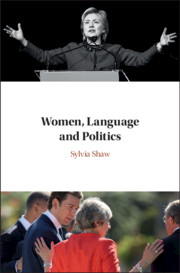Book contents
- Women, Language and Politics
- Women, Language and Politics
- Copyright page
- Dedication
- Contents
- Figures
- Tables
- Acknowledgements
- Abbreviations
- Transcription Conventions
- 1 Introduction
- 2 Gender and Language in Political Institutions
- 3 Women’s Linguistic Participation in a Traditional Male-Dominated Forum – The UK House of Commons
- 4 Women’s Linguistic Participation in the New Devolved Assemblies of the UK
- 5 Barriers to Women’s Participation in Politics
- 6 Case Study: Theresa May
- 7 Case Studies: Julia Gillard and Hillary Clinton
- 8 Women, Language and Politics
- Book part
- Notes
- References
- Index
1 - Introduction
Published online by Cambridge University Press: 08 May 2020
- Women, Language and Politics
- Women, Language and Politics
- Copyright page
- Dedication
- Contents
- Figures
- Tables
- Acknowledgements
- Abbreviations
- Transcription Conventions
- 1 Introduction
- 2 Gender and Language in Political Institutions
- 3 Women’s Linguistic Participation in a Traditional Male-Dominated Forum – The UK House of Commons
- 4 Women’s Linguistic Participation in the New Devolved Assemblies of the UK
- 5 Barriers to Women’s Participation in Politics
- 6 Case Study: Theresa May
- 7 Case Studies: Julia Gillard and Hillary Clinton
- 8 Women, Language and Politics
- Book part
- Notes
- References
- Index
Summary
This chapter starts by giving a theoretical definition of gender and its relation to language. It gives the rationale for the focus of the book on women politicians and a critical overview of work in the field of gender and language research investigating language and gender in the professional workplace. It also critically reviews linguistic research into political discourse and the much smaller body of work relating to gender, language and politics. In doing so it highlights the originality of the book’s focus on gender and the interactional details of political discourse in political institutions. The chapter also explains relevant theories and empirical research on women’s representation in politics from the discipline of political science. It describes research into the descriptive and substantive representation; examines current re-evaluations of the ‘critical mass’ theory; and examines the ‘different voice’ ideology relating to expectations about gender and communicative styles. It concludes by citing calls from political scientists for additional methods from a wider range of disciplines with which to measure women’s substantive representation and describes the overall structure of the book.
Keywords
- Type
- Chapter
- Information
- Women, Language and Politics , pp. 1 - 23Publisher: Cambridge University PressPrint publication year: 2020

